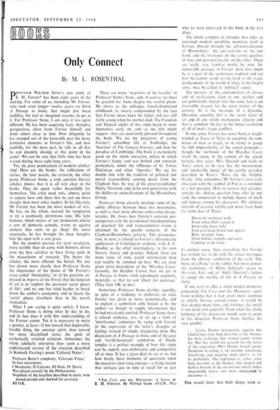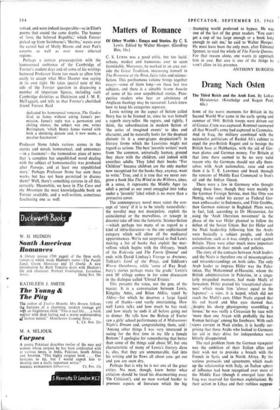Only Connect
By M. L. ROSENTHAL
PROFESSOR WILFRED STONE'S new study of E. M. Forster* has been eight years in the making. For some of us, including Mr Forster, who took even longer—twelve years—to finish A Passage to India, that might just mean inability, for real or imagined reasons, to get at it. For Professor Stone, I am sure, it was quite different. He has been acquiring facts, thoughts, perspectives, often from Forster himself and from others close to him. How diligently he has scooped out of the knowable past the many formative elements in Forster's life, and how tactfully, for the most part, he tells us all that he can decently divulge at this point in the game! We can be sure that little time has been wasted during these eight long years.
Yet, ah, poor predicament of modern scholar- ship! Here are the books: the collections of stories, the four novels, the criticism, the other prose. Professor Stone, a truly sensitive literary scholar, knows that it is all writ clear in the books. They do speak rather beautifully for themselves. The critic need only, almost, point to aspects here and there that he can see more sharply than most other readers. In his life-style, Mr Forster has been the most modest of wits. He has, on the whole, resisted the temptation to try a cosmically portentous tone. His light humour, which makes of our damnation almost a sort of domestic comedy,- warns us against analysis that. seeks to go 'deep.' Or, more accurately, he has brought his deep thoughts into the open with a rare grace.
But the modern passion for total revelation, more terrible than an army with banners, drives even the best scholars to bury living souls in the mausoleum of research. The better the scholar, the more efficient the burial. No one has shown more clearly than Professor Stone the importance of the theme of Mr Forster's essay called 'Anonymity,' or of his position, ex- pressed in Aspects of the Novel, that the function of art is to 'explore the passional secret places of life'; and no one has tried harder to break down the author's anonymity and to locate the `secret' places elsewhere than in the novels themselves.
What I am saying is quite unfair, I know. Professor Stone is doing what he has to do, and in fact does it with fine understanding of the Forster canon. Yet it is necessary to make a gesture, at least—if not toward that deplorable, lovable thing, the amateur spirit, then toward her more disciplined sister, the spirit of aesthetically oriented criticism. Sometimes the whole scholarly enterprise does seem a more sophisticated version of the situation described in Kenneth Fearing's poem 'Cultural Notes': Professor Burke's symphony, 'Colorado Vistas,' In four movements, I Mountains, II Canyons, III Dusk, IV Dawn, Was played recently by the Philharmonic. Snapshots of the localities described in music were passed around and checked for accuracy. All O.K. There are many 'snapshots of the locality' in Professor Stone's book, and, of course, we must be grateful for them, despite my wistful plaint. He shows us the unhappy, female-dominated childhood, its misery compounded by the fact that Forster never knew his father and was still fairly young when his mother died. The Freudian and Jungian angles of this study begin to show themselves early on, and—as the title might suggest—they are recurrently pursued throughout the book. We see the purgatory of young Forster's schoolboy life at Tonbridge. the `Sawston' of The Longest Journey, and then the paradise of Cambridge. The book is particularly good on the whole university milieu in which Forster's happy soul was bathed and renewed, particularly under the influence of G. Lowes Dickinson and other 'Apostles.' We see his double link with the tradition of political and moral responsibility coming down from the Clapham Sect, by way of his great-grandfather Henry Thornton, and, in his own generation, with the deliberate uninvolvement of the Bloomsbury Group.
Professor Stone cleverly develops some of the subtle affinities between these two movements, as well as their more obvious contrasting charac- teristics. He shows how Forster's constant pre- occupation with the paradoxical interdependence of practical life and transcendental vision is informed by the specific concerns of the Clapham-Bloomsbury polarity. This preoccupa- tion, in turn, is related to Forster's idiosyncratic application of Coleridgean aesthetic, with A. C. Bradley as the chief intermediary, to his own literary theory and practice. Indeed, there are more items of truly useful information than can readily be summed up here. We are even given more description of the `Marabar Caves' (actually, the Barabar Caves) than we get in A Passage to India—with reproduced snapshots, naturally, so that we can 'check for accuracy.' (They look OK to me.) Sometimes Professor Stone clarifies superbly, in spite of a tendency to elaborate on what Forster has given us more economically, and to explain a symbolism only hinted at by the author—as though to supply information that he had mistakenly omitted. Professor Stone shows a related tendency, too, to set up a kind of 'interference' sometimes by vying with Forster in the expression of the latter's thoughts or feelings instead of simply elucidating them. His discussion of A Passage to India and of the cave and 'world-mountain' symbolism of Hindu temples is a perfect example of how this study can be superb, over-elaborative and competitive all at once. It has a great deal to say to us, but how lovely those moments of quotation when the maestro's own voice emerges—a living stream that surfaces just in time to recall for us just
THE CAVE AND THE MOUNTAIN: A STUDY OF E. M. FORSTER. By Wilfred Stone. (0.U.P., 55s.)
why we were interested in this book in the first place.
The whole complex of attitudes that rides an informed modern sensibility manifests itself in Forster, filtered through the self-contradictions of Bloomsbury: the anti-activism on the one hand, and the insistence on the saving qualities of love and personal loyalty on the other. These are really very familiar motifs by now. In- numerable passages in Forster show how much he is a part of the aesiheticist tradition and yet how he cannot avoid staring hard at the tragic predicaments of the world in what, in the largest sense, may be called its 'political' aspect.
The mystery of the confrontation of classes and of civilisations alien to one another and yet pathetically locked into the same fate is an irresistible magnet for the great writers of the century. So is the mystique of a dynamic, liberating sexuality that is the secret force of art and of any vitally mythopoeic religion and that is somehow the key to the future resolution of all of man's tragic conflicts.
In one sense, Forster has never been as tough- minded as Joyce or Yeats in accepting the con- dition of man as tragic, or in trying to gauge the full impersonality of the sexual principle— though the 'ou-boum' of the Marabar Caves might be taken, in the context of the sexual hysteria that seizes Miss Quested and leads to Aziz's arrest, to be very like the monotonous and 'intolerable music' of the earthly paradise described in Yeats's 'News for the Delphic Oracle.' One remembers Mr Forster's own early obsession with the symbol of Pan as a reminder of a lost paradise. How to recover that paradise remains his abiding question long after he put aside the temptation to include figures of myth and fantasy among his characters. His ultimate referent of creative vitality can never have been far from that of Yeats:
Down the mountain walls From where Pan's cavern is Intolerable music falls.
Foul goat-head, brutal arm appear, Belly, shoulder, bum.
Flash fishlike; nymphs and satyrs Copulate in the foam.
another sense, then, everything that Forster has written has to do with the sexual mystique, from the obvious symbolism of the early 'The Story of a Panic' to the subtler but more power- ful revelations of Helen Schlegel's secret in Halyards End and of Adela Quested's failure to accept the totality of life in A Passage to India.
If one were to offer a single modest demurret concerning The Cave and the Mountain—apart from wishing that it had given more attention to strictly literary considerations—it would be that, despite many hints and skirtings, this motif is not dealt with centrally. Even when the whole tendency of his discussion would seem to point in this direction, Professor Stone declines his own gambit:
. Louise Dauner perceptively suggests that [Adela] met what Jung describes as the Animus, the male archetype that woman carries within her. But this would not account for the terror of the experience (Miss Dauner herself quotes Neumann in calling it 'an invisible stimulating, fructifying. and inspiring male spirit'). or for its profundity. The experience is. rather, what Jung describes as the Shadow. that deepest and darkest bottom of the unconscious which strikes unspeakable horror into those unequipped to encounter it. . .
One would think that both things were in-
volved, and were indeed inseparable—as in Eliot's poems that sound the same depths. The banner of 'love, the beloved Republic,' which Forster picked up from Swinburne's 'Hertha,' waves over the carnal bed of Molly Bloom and over Pan's caverns as well as over more ethereal regions.
Perhaps a certain preoccupation with the homosexual ambience of the Cambridge of Forster's student days and of some of his writings bemused Professor Stone too much to allow him easily to accept what Miss Dauner was saying in its own right. He takes special note of this side of the Forster question in discussing a number of important figures, including such Cambridge divinities as Dickins'on and J. M. E. McTaggart, and tells us that Forster's cherished friend Forrest Reid
dedicated his homosexual romance, The Garden God, to James without asking James's per- mission. James's reply was a permanent and chilling silence; the subject was one, writes Burlingham, 'which Henry James viewed with both a shrinking distaste and, it now seems, a peculiar fascination.'
Professor Stone labels various scenes in the stories and novels homosexual, and announces —in a footnote !—the tremendous piece of news that 'a complete but unpublished novel dealing with the subject of homosexuality was produced after Passage, and at least one unpublished story.' Perhaps Professor Stone has seen these works but has not been permitted to discuss them? Well, there's something curious in all this, certainly. Meanwhile, we have in The Cave and the Mountain the most knowledgeable book on Forster available, and a well-written, sometimes fascinating one as well.



































 Previous page
Previous page